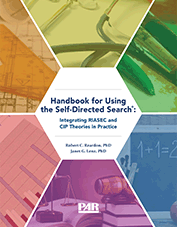 Recently, Holland and Messer’s Self-Directed Search (SDS) Form R, 5th Edition was revised and published along with associating forms, formats, and materials. In response to these developments, Reardon and Lenz assembled an updated guide for “practitioners seeking to enhance their use of the SDS or (for) our graduate students learning to be career counselors or advisors” (p. iii). The Handbook that resulted contains a trove of content both applicable for practice and theoretically anchored. Notably, the authors detail a novel approach for interpreting the SDS using Holland’s theory in concert with cognitive information processing (CIP). The following review of the spiral-bound, paperback Handbook begins with a summary of its 12 chapters. Then strengths, limitations, and an overall appraisal of the text are provided.
Recently, Holland and Messer’s Self-Directed Search (SDS) Form R, 5th Edition was revised and published along with associating forms, formats, and materials. In response to these developments, Reardon and Lenz assembled an updated guide for “practitioners seeking to enhance their use of the SDS or (for) our graduate students learning to be career counselors or advisors” (p. iii). The Handbook that resulted contains a trove of content both applicable for practice and theoretically anchored. Notably, the authors detail a novel approach for interpreting the SDS using Holland’s theory in concert with cognitive information processing (CIP). The following review of the spiral-bound, paperback Handbook begins with a summary of its 12 chapters. Then strengths, limitations, and an overall appraisal of the text are provided.
Chapter 1 presents a candid case study of John Holland’s own RIASEC profile scores, placing his theory and the SDS into greater context. “Experienced SDS users will recognize (Holland) as a case of an undifferentiated, elevated profile” (p. 2). Following such insight into Holland’s personality, tenets of RIASEC theory are outlined (Chapters 2 and 3). In doing so, common myths are addressed, such as the misstatement that “RIASEC types are not applicable to persons of different racial and ethnic heritages” (p. 12).
After RIASEC theory, Reardon and Lenz delve into the SDS as an instrument and career intervention (Chapters 4 and 5). Here, SDS components and their applicability are detailed (e.g., Occupations Finder, Educational Opportunities Finder [EOF], You and Your Career [YYC] booklet). Highlighted too is a much needed Veterans and Military Occupations Finder (VMOF). This new instrument “allows users to better understand how the skills and abilities developed in the military relate to civilian occupations with similar requirements” (p. 67).
Chapters 7–9 explain the CIP model for improving SDS interpretability. As the authors assert, “Using all of the interpretive and diagnostic information provided by the SDS within the context of a CIP-based service delivery system can provide most, if not all, of the critical ingredients in effective career interventions” (p. 95). A career decision-making process derived from CIP, called the CASVE cycle, is explained as being especially beneficial. To further illustrate the synergy between CIP and RIASEC, four SDS case studies are reviewed in Chapter 10. Concluding the book is a discussion of career service models at the programmatic level (Chapter 11), and then future trends in SDS application (Chapter 12).
Through explaining SDS administration and interpretation, Reardon and Lenz effectively link RIASEC and CIP theories to practice. This theory-to-practice linkage was achieved with clever decisions to limit “referencing, statistics, and academic detail” to make content more palatable for practitioners and students (Preface, p. iii). According to the authors, “We were also especially mindful that counselors are primarily SAE (Social, Artistic, Enterprising) types” (Preface, p. iii). As a result, the writing style is refreshingly personable and enriching.
Additionally, a myriad of tables, figures, and case studies are presented throughout the book. There are 29 figures, 14 tables, and 13 appendices to help facilitate SDS interpretation. For instance, Table 3.2 describes career interventions for certain Holland types (p. 24). Other examples include a table for SDS indicators and diagnostic signs, and guidelines for using the SDS in conjunction with the CIP approach is found under Appendix J (p. 214).
Though containing numerous strengths, the Handbook lacks content on special populations, especially people with disabilities. Indeed, the authors discuss the SDS Form E (Easy) as an alternative to Form R (Regular) for those with limited reading skills, and an audiotape version (1990) of Form E is said to be available (p. 71). However, discussion of other testing modifications or accommodations for those with different disabilities is absent. Furthermore, the psychometric properties of Form E receive limited attention. While the authors direct readers to studies in the career literature for Form E with special populations, Reardon and Lenz did not detail the findings (p. 71).
In the book, Reardon quotes a former student who, upon learning Holland’s theory of six personality types and environments, asked cheekily, “Is that all there is to it?” (p. 21). The student’s remark reflects a common misperception that Holland’s theory is too simple. However, Reardon and Lenz perfectly illustrate the simplicity and the complexity of this theory that underpins the SDS. As a result, the Handbook will help practitioners (a) glean maximum information from SDS results, (b) gain an understanding of how RIASEC theory and CIP can inform service delivery, and (c) help improve career outcomes for clients.
Reardon, R. C., & Lenz, J. G. (2015). Handbook for using the Self-Directed Search: Integrating RIASEC and CIP theories in practice. Lutz, FL: PAR.
Reviewed by: Matthew McClanahan, East Carolina University
The Professional Counselor
